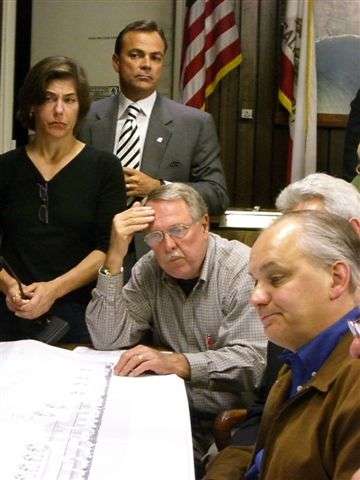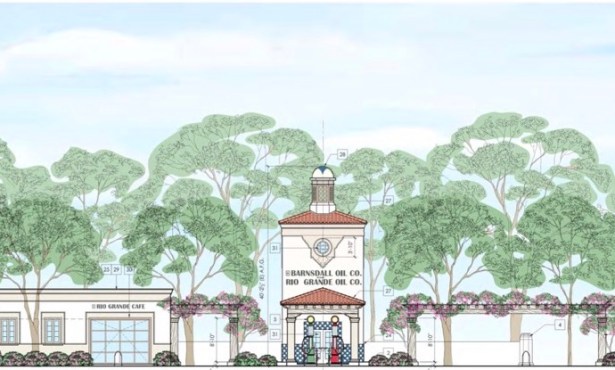Miramar Hotel Emails Raise Questions
Investigation of Government Correspondence Reveals Interesting Details Just As Montecito Planning Commission Readies for Wednesday's Project Review
In January 2007, Los Angeles developer – and potential L.A. mayoral candidate – Rick Caruso bought the Miramar property in Montecito and began the rigorous process to remodel the historic hotel, a move that was quickly welcomed for the once iconic seaside hotel. Though a renovation project was already okayed for the site nearly a decade ago, its approval is several years old, and some residents believe Caruso’s current plans alter the footprint of the property and deviate far from what was approved. Because of these changes, some are arguing that a full environmental impact report must be done on the property. But that study, which costs plenty of both time and money, is something that Caruso has indicated he won’t pursue.
With so many opinions and so much money resting on the result, it’s not too surprising that there have been plenty of staff shake-ups in the halls of the County of Santa Barbara due to Caruso’s Miramar dream: planners have been taken off the controversial project, and one staff member even quit her job due to disagreements with superiors. Despite such changes, however, county officials-in-the-know have not offered any clear explanations; instead, they are bouncing all questions to county spokesperson William Boyer, who’s never shined much light on the subject. Since no one was talking, The Independent decided to look into the matter, and I spent a series of days sifting through all correspondence and information within the county regarding the Miramar.

Our newspaper wasn’t the first group to request a search of public records regarding the Miramar. Attorney Marco Gonzalez, whose Coast Law Group represents the Citizens Planning Association, also conducted a search, and released to the media some of his findings, much of which corroborated what I found. Gonzalez said much of the information reveals “just how far the project applicant and his representatives were able to override legitimate staff concerns with the environmental review for the project.” Most of what we both read through was correspondence among county staff, featuring a lot of communication with Matt Middlebrook, Caruso’s vice president for governmental relations, and various consultants. Very little documentation of physical meetings and conference calls was available, other than those that were planned to occur. But here – just two days before Caruso’s Miramar application goes before the Montecito Planning Commission in an all-day hearing on Wednesday, July 16, beginning at 9 a.m. – is a result of some of our findings.
Pressure Drop
My investigation was chiefly prompted by the largely unexplained exit of county planner Michelle Gibbs. As reported in June, Gibbs, who took over as Miramar project manager in October, asked to be taken off the project, and then quit her job entirely, giving a two-week notice to end on June 2. But she was asked to leave, with pay, on May 28, and was escorted from the building.
Gibbs’s emails to her bosses clearly indicate disputes. Before her departure, Gibbs raised concerns about the Miramar project’s process and, on April 16, she asked Planning and Development Deputy Director Dave Ward if she could be taken off the project. “I do not feel that I can adequately explain or defend our environmental impact analysis or policy consistency analysis to members of the public, or to decision-makers in a hearing,” Gibbs wrote. She felt rushed in what she was being asked to do, and suggested in her letter that Ward even changed one alternative from “feasible” to “infeasible.” Gibbs also indicated that she didn’t want to sign her name to the environmental report.
Even before then, Gibbs sent an email on March 28 to Ward discussing a CEQA (California Environmental Quality Act) guideline regarding the county’s decision to use an addendum procedure in its environmental review. “Again, as I completely disagree with this finding,” she wrote, “it is your call on how this text is written.”
Later, on May 7, Gibbs emailed planner Anne Almy to say, “As I understand from you, I need to discuss some things that I need to improve on in my self evaluation.” Almy responded by telling her to “put in writing your thoughts on the Miramar-related events and work challenges that have occurred over the past while. I think you need to reflect back on the meeting held on April 16, 2008, between [Planning and Development Assistant Director] Dianne [Black], Dave, you, and me wherein conduct, interpersonal relationships, and performance were discussed.”
Gibbs’ “performance” as planner had also taken a hit just days earlier from Ward, who wrote a scathing email due to an uncompleted assignment. “I continue to be dismayed that this task remains incomplete,” Ward wrote. “Unacceptable. This is not an insignificant administrative task – it has direct purpose : Immediately have a secretary drive around to collect signatures.”

To that, Gibbs responded, “I’m sorry, but you never once indicated that you wanted me to ask administrative staff to drive the charter around to get signatures.” She explained that she wasn’t the original planner, so had no way of knowing that move was necessary. “Since our meeting with [SEIU union representative] George Greene,” wrote Gibbs, “you have done nothing but harass me on this case and this email is just another example.”
But Gibbs was not the first planner to have trepidations about Caruso’s Miramar. She took over as Miramar project manager for county planner Julie Harris, who also had many issues with the applicant’s procedure and ethics. In a June 19, 2007, email, Harris points to a Montecito Journal article that mentioned a yet-to-be-scheduled Montecito Planning Commission meeting, and wrote, “The applicant is trying to lock us into something that cannot be set at this time.” Harris expressed concern on the Miramar timeline draft in a long July 17, 2007, email, explaining to planner June Pujo and Deputy Director Ward that “I have much wrong with it. As I have already raised several times, I am opposed to giving the applicant unrealistic expectations.” Harris called the timeline “aggressive and unrealistic” and wrote that she was “opposed to creating a timeline that puts so much pressure on staff.” She later opined that the project was “a nearly impossible situation to work with and I have never had to deal with this on any other project.”
Pressure, however, was apparently being put on Harris whether she knew it or not, as the planner was already the cause of worries for county staff and Montecito residents. In an August 18 email, Deputy Director Ward sent some of his “edits” of Harris’s analysis to planner Pujo, in anticipation of the upcoming Montecito Board of Architectural Review and Planning Commission hearings. Ward explained, “Here are my edits so you can see where Julie [Harris] still remains a bit off our collegial team expectation. We talked some regarding this and also her current review of applicant plans. She made two comments regarding applicant effort late Friday that made me cringe. I’d say Julie is probably at about 70 percent where we want her. I remain concerned.”
Around that same time, resident Greg Huglin sent an email to Derek Johnson, deputy director of the county’s Office of Long Range Planning, explaining that he had received a call from an upset Caruso, who indicated Harris only gave Caruso an hour to meet, and at the end told him, “Time’s up!”
“Pretty fuckin’ arrogant of her, in my opinion,” wrote Huglin. “She perhaps forgets who she is working for. Is there any way she can be tuned before Rick complains about the dismissive treatment he feels he’s getting? You, me, and the public want this to succeed and if Julie [Harris] is already pulling this crap on them, it’s gonna be a problem.” Less than two months later, Harris was pulled from the project.
Email Trail
Being rushed was not just a figment of Harris’s imagination for many emails from various county staff also indicate concerns about a fast-tracked Miramar, oftentimes referencing Caruso’s people as pushing a way-too-speedy timeline. Here are a few:
• Dale Weber, a former development engineer with the county’s flood control district, called the case a high-profile one with “an applicant who has an unrealistic timeline.”
• Ray Ketzel, a member of the Montecito Board of Architectural Review (MBAR), wrote in September that Caruso needs to “slow down and not try to throw too much at the county at one time.”
• County planner Laura Bridley, in a January 2008 email to Pujo and P&D assistant director Black, said she fielded a call from Ty Warner representative Greg Rice, who had “some complaints about why he thought the Miramar was getting an easier time of it than Ty Warner did.”
• In a March 19 email to 1st District Supervisor Salud Carbajal and the county’s CEO Mike Brown, Planning and Development Director John Baker said, “Our goal all along has been to provide the path for approval that will not have obstacles that will result in lengthy delays.”
• CEO Brown’s assistant sent an email in March explaining that, at the direction of Carbajal, a meeting involving county staff, Middlebrook, and Caruso would be set up to “discuss unacceptable delays.”
• Jon Frye, flood control engineering manager, said in November that Brown had the project on his radar to “get the bed tax going.”
While some of the heat was no doubt coming from CEO Brown, some of it was also coming from Caruso. Frye notes that consultant Craig Steward from Penfield and Smith, which was doing work for Caruso on a drainage report, told him that he was directed by the developer not to put anything down in writing. Reports indicate a similar edict was given to county staff after CPA’s attorney Gonzalez made his public records request in May.

Also, as indicated in a March 20 email from Middlebrook to Black following a conference call: “Just want to acknowledge that I know you and the staff are working very hard to finish the documents and did not intend to imply otherwise.” Ward responds to Black, saying, “I think Matt [Midddlebrook] is sincere. Pressure remains on all sides.”
Fears of Flood
And then there’s the flood issue. County emails document many scheduled meetings between staff and the applicant, as well as among staffers, to discuss potential issues with a floodplain on the Miramar property. Residents and groups monitoring the project also have shared concerns about the floodplain.
Engineering expert Frye seems to lead the charge in questioning the site’s ability to handle flooding, or at least the sufficiency of Caruso team’s analysis. Caruso had Penfield & Smith do a drainage study, and Frye indicated the study is “light” on the impacts of the project to Oak Creek, and also doesn’t address overflows from San Ysidro Creek should it become plugged. Despite warnings about the issue from Frye, Middlebrook informed Gibbs, “[I]t is our belief that our analysis of the flood hazard area as submitted with out application in November is sufficient.”
In February, a civil engineering associate with the county’s flood control district pointed out “a fatal flaw assumption in the modeling approach” that Penfield & Smith took, according to Frye, giving him “even less confidence” in the work completed. The associate, Candice Constantine, noted, “[T]hey aren’t going to like the results, hence the resistance.” Frye indicates in a later email they haven’t come to a conclusion on whether there is a potential adverse impact because of the report, but that it needs looking into.
A newer Penfield & Smith report concludes the “impacts are indeed minimal, if at all.” That’s from a March 14 email sent by Tom Fayram, deputy Public Works director, which reversed an email from three days prior, when he explained that any more filling of the floodplain wouldn’t be allowed.

Three days later, Gibbs asked Frye if he concurred with Fayram’s analysis. Frye, in turn, responded directly to Fayram, explaining, “I don’t want to review the study quite frankly. As you said this morning, it’s the project engineer’s responsibility to do the details correctly, and you have already reviewed the bigger picture stuff. From another perspective, I prefer to have absolutely no comment to this study for the very reason that I haven’t looked at it and I haven’t looked at it because my boss did not direct me to look at it. That way, no matter who gets hold of me, I have nothing to say, good bad or indifferent.”
Caruso’s Community Cronies
Most anyone, whether they are for a full environmental review or not, are tired of a rat-infested eyesore just off Highway 101 in a highly visible part of town. From Caruso’s side, Middlebrook has claimed overwhelming support for the project, and disregards these allegations as coming from a small group of people who are trying to keep any project from being built. In chorus with that assumption, various newspapers over the past few weeks have featured full-page advertisements from “Friends of Montecito” – including Gene Montesano, Bob and Catherine Remak, Nina Terzian, Mary Belle Snow, Bob Hazard, and others – urging their neighbors to support the project.
“The Caruso team has developed a great plan for the Miramar,” the published letter states. “It is the right plan. It fits into Montecito. It brings back the elegance and charm of the old Miramar while creating something fresh and new.”
On Wednesday, the validity of those sentiments will be publicly aired once again.



